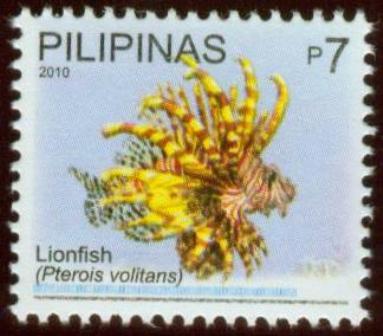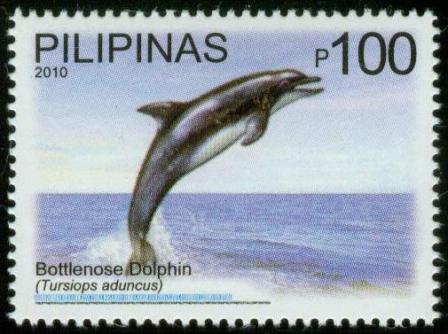2010, May 13. Philippine Marine Biodiversity - Definitives
Litho Offset. Amstar Company, Inc. Perf. 13.5
7p, Singles, Sheets of 100 (10 x 10); 100p, Singles, Sheets of 50 (5 x 10)

7p - Lionfish - Singles (11,333,300)
100p - Bottlenose Dolphin - Singles (203,300)
Designer: Darwin A. Marfil (7p);
Graphic Artist: Jiomer E. Dacaymat
Design Coordinators: Victorino Z. Serevo; Elenita D.L. San Diego
Source: Coral Reef Animals of the Indo-Pacific by Dr. Terence Gosliner
First Day Covers: Manila
The red lionfish (Pterois volitans) is a venomous coral reef fish in the family Scorpaenidae. It inhabits the Indian and western Pacific Oceans. Adults can grow as large as 17 inches (43 cm) in length while juveniles may be shorter than 1 inch (2.5 cm). It has fleshy tentacles which protrude from both above the eyes and below the mouth. The pectoral fin is present in a distinctive fan-like shape, and dorsal spines are long and separated. Every spine of the lionfish is venomous, and while no fatalities due to lionfish stings have been reported, their venom extremely painful. The Red Lionfish eat live prey and do not eat fish flakes and other processed food. (http://en.wikipedia.org/wiki/Red_lionfish)
Bottlenose dolphins (Tursiops aduncus), are the most common and well-known members of the family Delphinidae, the family of oceanic dolphins. Bottlenose dolphins live in groups typically of 10-30 members, called pods, but group size varies from single individuals up to more than 1,000. Their diet consists mainly of forage fish. Dolphins often work as a team to harvest fish schools, but they also hunt individually. Dolphins search for prey primarily using echolocation, which is similar to sonar. They emit clicking sounds and listen for the return echo to determine the location and shape of nearby items, including potential prey. Bottlenose dolphins also use sound for communication, including squeaks and whistles emitted from the blowhole and sounds emitted through body language, such as leaping from the water and slapping their tails on the water surface. (http://en.wikipedia.org/wiki/Bottlenose_dolphin)
-
Marine Biodiversity
-
Marine Life
